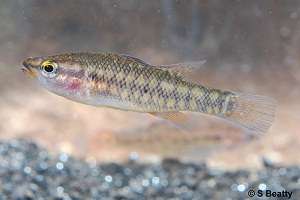Saving vulnerable Australian fish species

Nearly one year into a study on the three rarest fish species in WA's south-west zone is already yielding invaluable data to aid in developing action plans that may save their future.
The three target species are; the trout minnow (Galaxias truttaceus); Balston's pygmy perch (Nannatherina balstoni); and the recently described little pygmy perch (Nannoperca pygmaea), which may be the rarest freshwater fish in Australia.
Murdoch University Freshwater Fish Group & Fish Health Unit researchers Dr Stephen Beatty and Dr David Morgan discovered the little pygmy perch in Denmark in 2009.
Dr Beatty says previous research had revealed serious knowledge gaps, particularly about the little pygmy perch, so the aim of this project is to develop a prioritisation list of on-ground actions for all three species.
Such actions include; protecting refuge pools; potentially recommending areas for rehabilitation and vegetation repair; and developing a list of things like in-stream barriers that may be impacting the ecology of the species' spawning migration.
Dr Beatty says these methods have so far proven to be very successful, for example, data collected by Dr Morgan on the western trout minnow in previous years resulted in the construction of a vertical slot fishway on the Goodga River to increase its habitat.
However, Dr Beatty says these results come after copious effort.
"We do refuge pool mapping and ground-truthing; which means hiking into different pools and finding out whether different species are using them as refuges," Dr Beatty says.
"Quite often, with these somewhat remote systems, [you really need to] hover above in a helicopter in order to document a habitat—and then go back and actually walk into them."
Dr Beatty says the team has the least amount of knowledge on the little pygmy perch, and gathering robust data is essential so that it may be considered for the critically endangered list.
"But in the first year of sampling we already think it has to retreat into the Hay River from the Mitchell River," he says.
"And it's really restricted [about 95 per cent of the population] to one river pool which is only about 100m long, which makes it very vulnerable to anything that may happen to that one pool."
Some of the issues in these areas result from feral pigs, which can damage the banks and defecate in the water.
However, Dr Beatty says the most important aspect is to ensure that groundwater abstraction does not potentially dry up these habitats.
Provided by Science Network WA


















